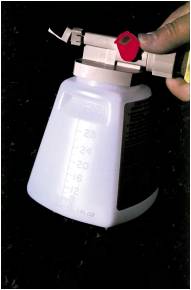HOW DO I CALIBRATE A HOSE-END SPRAYER? (For Spraying Plants)
Calibration Steps |
Sample Problem |
|---|---|
| 1. Select a single plant or a group of plants (e.g., a tree, a 20-foot row of vegetable plants, or a 100 ft2 flower bed). | one 10-foot apple tree |
| 2. Do not add pesticide to the water used in this step because you are merely trying to determine how long it takes to treat the designated plant(s). Using plain water in your hose-end sprayer, spray the plant(s) designated in Step 1 until all of the leaves, stems, and trunks are completely covered. Record how much time it takes. Note: Many product labels instruct you to spray until runoff, i.e., until the spray material begins to drip off the leaves.
However, it is better to stop just before that point is reached because the material that drips onto the ground is wasted. |
35 seconds required to treat the 10-foot apple tree
|
| 3. Spray water into a bucket for the amount of time determined in Step 2.
Measure and record the amount of water collected in the bucket. |
2 qt water collected in 35 seconds |
| 4. Determine the total number of plants or overall size of the planting that will be treated (e.g., 6 trees or a 100-ft row of vegetables). | 6 apple trees will be treated |
| 5. Multiply the number of plants or length of the overall planting from Step
4 by the amount of water collected in Step 3. This will determine the total amount of water required for the job. |
6 trees x 2 qt water/tree = 12 qt
12 qt ÷ 4 qt/ gal = 3 gal water required for the job |
| 6. Read the label to determine the proper rate (amount of product per gallon of water). Multiply the recommended rate by the amount of water determined in Step 5 | Rate = 1 oz / gal water 3 gal water x 1 oz/gal = 3 oz of the product required to treat 6 trees |
HOW DO I CALIBRATE A HOSE-END SPRAYER? (For Spraying Turf)
Calibration Steps |
Sample Problem |
| 1. Attach the hose-end sprayer (container empty) to the hose and open the water faucet fully | |
| 2. Spray the test area with plain water and record the amount of time it takes to cover the test area while walking at a comfortable, consistent speed. | 20 seconds to walk and cover 250 ft2 |
| 3. Using the hose-end sprayer, spray plain water into a bucket for the time recorded in Step 2, then measure the amount of water collected. | 1.25 gal of water collected in 20 seconds |
| 4. Divide the total area to be treated by the area covered in Step 2. Multiply the result by the number of gallons collected in Step 3 to determine the total gallons of water that would be applied to a 1000- square-foot lawn at your walking speed | 1000 ft2 ÷ 250 ft2 = 4
4 x 1.25 gal = 5 gal of water |
| 5. Check the product label for the required amount of water per 1000 square feet (this is not always provided) and compare it to the amount obtained in Step 4. In this example, the label said to use 2-4 gallons of water per 1000 square feet. | 5 gallons of water will be too much based on the label requirement |
| 6. Recalibrate your sprayer by walking over the test area somewhat faster than in Step 2, and premeasured the amount of water as in Step 3 | During the second test, you walked the 250 ft2test area in 15 seconds and sprayed 0.75 gal of water into a bucket.
For 1000 ft2; 4 x 0.75 gal =3 gal/1000 ft2 |
| 7a. Compute the amount of water that will be required to treat the lawn by first dividing its total area by 1000 square feet.
7b. Multiply the amount of water required per 1000 sq ft times the number in 7a |
6300 ft2 ÷1000 ft2= 6.3
3 gal/1000 ft2x 6.3 = 18.9 gal required |
| 8. Compute the amount of product needed to treat the lawn by multiplying the amount of product required per 1000 sq ft times the number in 7a. | 4 oz/1000ft2x 6.3 =
25.2 oz of product needed (round off to 25 oz) |
Compiled by Wayne Buhler, PhD.

